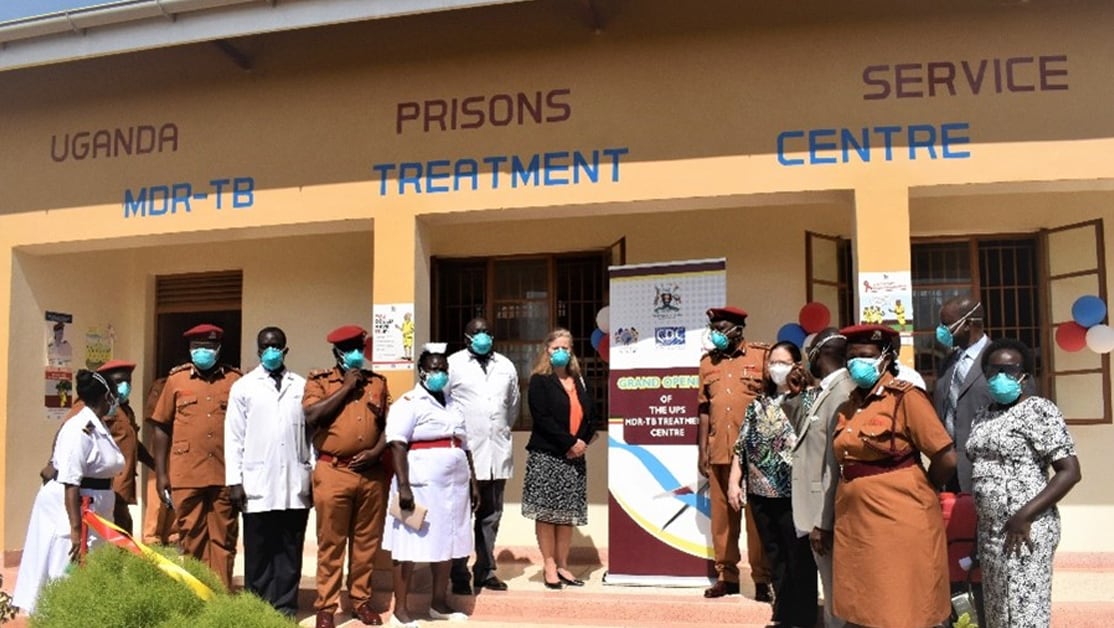At a glance
This story describes the challenges people living with HIV who are at higher risk for TB face in accessing TB testing and treatment. With support from PEPFAR, CDC is customizing HIV and TB services to deliver high-quality care to people who are incarcerated.

Background
Tuberculosis (TB) is the leading cause of death for people living with HIV (PLHIV). People who are incarcerated are at higher risk for HIV and TB. Providing quality and timely care for people who are incarcerated improves their health outcomes and reduces community spread beyond prisons.
With support from the U.S. President’s Emergency Plan for AIDS Relief (PEPFAR), CDC is tailoring HIV and TB services and programs in Uganda and South Africa. These efforts aim to meet the unique needs of people who are incarcerated and provide high-quality care.
HIV and TB among people who are incarcerated
Internationally, prisons have reported high rates of both HIV and TB. The United Nations Office on Drugs and Crime estimates that out of the 11 million people detained worldwide in prisons and other closed settings, 528,000 are living with HIV. According to the U.S. Agency for International Development, TB incidence among people who are incarcerated is 5 to 70 times greater than in outside communities. This rate is due to severe overcrowding, poor nutrition and ventilation, and insufficient access to healthcare.
Additionally, Multi-Drug Resistant TB (MDR-TB), which is defined as resistance to the two first-line TB drugs, is four times higher in prisons than in the general population. CDC Uganda TB expert, Dr. Deus Lukoye, recognizes the issue that MDR-TB causes among populations.
CDC support in Uganda prisons
CDC Uganda has supported the Uganda Prison System (UPS) since 2005 to address MDR-TB in prisons by providing:
Diagnostic and clinical services
With support from PEPFAR, CDC provides diagnostic and clinical services within a dedicated treatment center for people who are incarcerated with MDR-TB.
Training and mentorship
CDC equipped and furnished the ward and provides ongoing training and mentorship for the UPS medical team. This ensures the safe and effective management of MDR-TB in prisons.
Laboratory renovations
CDC renovated laboratories in five regional referral hospitals. The renovation improves the time to diagnosis and referral of MDR-TB cases among people who are incarcerated. CDC is also renovating the UPS primary reference laboratory.
Diagnostic machinery
CDC also provided six GeneXpert® machines to regional prison facilities. These machines are state-of-the-art diagnostic equipment for TB that shorten the time to diagnose drug-resistant strains of TB from weeks to only a few hours.
Delivery transportation
Finally, to ensure no people who are incarcerated with suspected MDR-TB are left undetected, CDC helped provide 14 motorcycles to facilities without GeneXpert® machines to aid specimen delivery for testing. Before these diagnostic services were established in prisons, MDR-TB was often diagnosed late leading to devastating outcomes.
Eli's story
The impact of the new ward continues to be felt. Eli, 42 years od, is just a few months away from finishing treatment and he cannot wait. "Three months, to be exact," he says, waving three fingers on his right hand. "I have religiously taken my medicines and counting down to a clean bill of health."
Eli, who has been in prison for six years now, first tested positive for TB in July 2019 while incarcerated in a regional facility. However, in 2020, he checked himself into the prison clinic and was diagnosed with MDR-TB after his TB symptoms resurfaced.
Eli is now culture-negative, off the ward, and re-integrated with other inmates. With all he has learned, Eli now provides peer support to those who test positive for TB. He encourages them to look beyond the treatment side effects and adhere to their treatment in order to get well.
Leveraging impact in South Africa
In 2021, CDC South Africa, with support from PEPFAR and implementing partner TB HIV Care, piloted a novel study at the Goodwood Correctional Centre. The study aimed to assess integrating viral hepatitis services into the existing HIV program.
Dr. Joel Steingo, Correctional Services Programme Director at TB HIV Care, said conducting this study in a correctional setting is critical as hepatitis B (HBV) and hepatitis C (HCV) have similar transmission routes as HIV.
"The limited data available from South Africa shows a high prevalence of both HBV (up to 3.4 percent) and HCV (up to 6.4 percent) in correctional settings. If untreated, both HBV and HCV can lead to life-threatening complications such as liver cirrhosis and liver cancer. Despite this, viral hepatitis has been largely neglected at a primary healthcare level – including in the correctional centers – in South Africa," he explained.
The study investigators aim to administer the HBV vaccine to 750 people by mid-2022. As of March 2022, 201 individuals had received their first dose of the vaccine, 98 had received the second dose, and 54 had received the third dose. Additionally, 738 people have been tested for hepatitis since the study began – 30 had HBV, 4 had HCV, and 5 had HIV.
Helen Savva, CDC Key Populations Lead, said the study results would strengthen the knowledge and programmatic implementation in prisons in South Africa.
“The data will also provide a platform for strengthening government policy, particularly supporting inmates in correctional facilities and other members of key populations,” she added.
Quality care for all
Providing quality and timely care for people who are incarcerated improves their health outcomes and reduces community spread beyond prisons. Penitentiaries can often become reservoirs for infectious diseases like TB, HIV, and hepatitis. This endangers not only inmates but also guards, civilians, and visitors, which can threaten the health of the public outside of the prison systems.
CDC is dedicated to supporting testing, quality treatment, and disease prevention measures in this key population to help eliminate TB and achieve HIV epidemic control.
